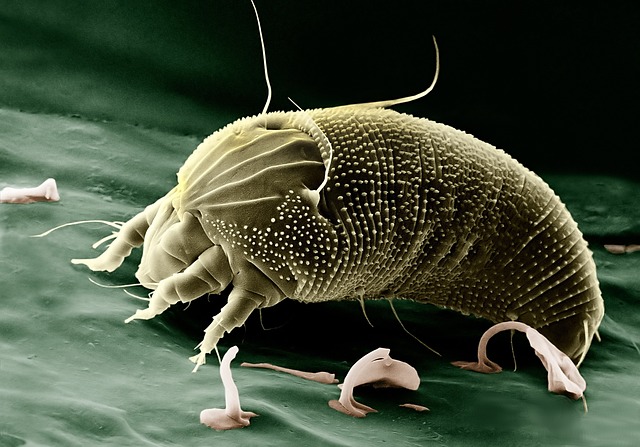Clover mite infestations follow seasonal patterns, peaking in warm spring and summer due to ideal food sources and conditions. These tiny pests can severely damage lawns and shrubs. Proactive measures like professional clover mites prevention services, regular inspections, proper maintenance, and at-home practices are crucial for early detection and effective control, fostering healthier landscapes. If traditional methods fail or infestations surge, consider specialized clover mites prevention services for long-lasting protection against these persistent pests.
In the ever-changing seasons, understanding clover mite infestations’ temporal patterns is key to proactive management. This article explores the seasonal trends of these pesky critters, offering insights into their common appearance times and favored habitats. We’ll guide you through effective prevention strategies, from DIY tips to professional clover mites prevention services. By the end, you’ll be equipped with the knowledge to protect your space year-round.
Understanding Seasonal Patterns in Clover Mite Infestations
Clover mite infestations follow distinct seasonal patterns, with peak activity typically occurring in warm spring and summer months. Understanding these trends is crucial for effective clover mites prevention services. During these warmer seasons, clover mites proliferate rapidly due to ample food sources and favorable environmental conditions. They feed on a variety of plants, including lawn grasses and ornamental shrubs, causing significant damage if left unchecked.
By recognizing when and where infestations are most likely to occur, homeowners and professionals alike can implement proactive measures. Seasonal trends also allow for the scheduling of targeted treatments, ensuring maximum effectiveness in mitigating clover mite populations before they reach detrimental levels. Proactive management strategies, coupled with seasonal knowledge, play a vital role in maintaining lush, healthy landscapes free from these persistent pests.
Common Times and Places for Outbreaks
Clover mite infestations often peak during specific seasons, with warm and dry weather conditions being particularly favorable for their proliferation. In many regions, outbreaks typically occur in late spring to early summer when the mites emerge from their winter dormancy. As the temperatures rise, these tiny pests become more active, feeding on various plant materials, including lawn grasses and ornamental shrubs.
Commonly affected areas include garden beds, lawns, and landscapes where clover or other host plants are present. Outbreaks can be especially problematic in regions with abundant sunlight and minimal rainfall, creating the perfect environment for clover mites to thrive. Homeowners and landscaping professionals alike should remain vigilant during these peak seasons, as early detection is key to effective clover mite prevention services. Regular inspections and proper maintenance practices can significantly reduce the risk of infestations and promote a healthier, pest-free outdoor space.
Prevention Strategies: What You Can Do
Clover mite infestations can be a seasonal nuisance, but there are proactive steps you can take to prevent them from taking over your space. One of the most effective strategies is to engage professional clover mite prevention services that offer tailored solutions for your specific needs. These experts will identify potential entry points and treat areas around your property to deter these pesky critters. Regular inspections are key; scheduling periodic assessments allows for early detection of any signs of infestation, making treatment more effective and cost-efficient.
In addition to professional help, there are simple at-home measures that can significantly reduce the risk. Keeping your home clean and clutter-free eliminates hidden spots where mites might breed. Regularly vacuuming with a HEPA filter and washing linens at high temperatures can also help eliminate any existing mites or eggs. Seal any cracks or gaps around windows and doors to prevent them from entering, and consider using natural repellents like citronella or lavender oil as an extra barrier.
Professional Clover Mite Prevention Services: When to Hire Experts
Clover mite infestations can be a significant concern for homeowners and businesses alike, especially during certain seasons. If you’ve noticed an unprecedented increase in clover mites or found that traditional prevention methods are not effective, it’s time to consider professional clover mites prevention services.
Experts in this field have the specialized knowledge and tools to effectively monitor, identify, and eliminate clover mite infestations. They can provide tailored solutions based on your specific needs and property characteristics. Hiring professionals is particularly recommended for severe or recurrent infestations, as they can help prevent future outbreaks by offering long-lasting protection. This proactive approach ensures a comfortable living or working environment, free from the persistent hassle of clover mites.
Understanding the seasonal trends of clover mite infestations is key to effective prevention. By knowing the common times and places outbreaks occur, homeowners and professionals alike can implement proactive strategies. Regular inspections, proper landscaping, and timely treatments are essential tools in the battle against these pesky mites. For severe or hard-to-reach infestations, considering professional clover mite prevention services can offer peace of mind and long-lasting protection. With a combination of DIY measures and expert interventions, it’s possible to minimize the impact of seasonal trends and enjoy a mite-free environment.
